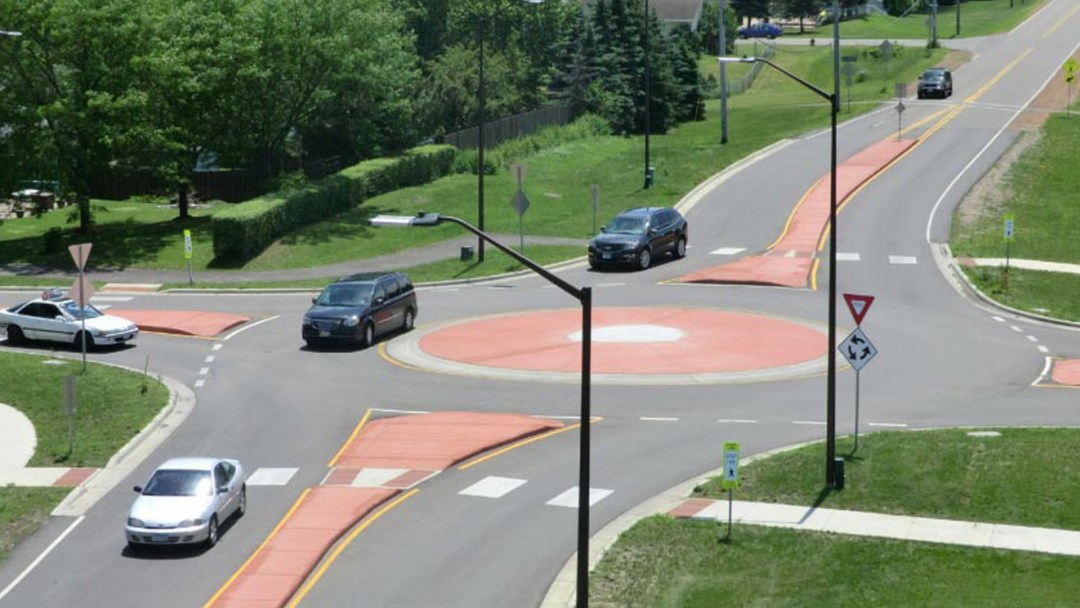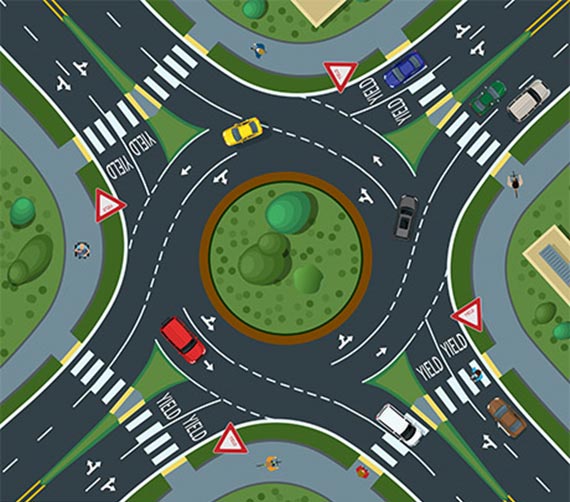
Transforming Intersections for Enhanced Safety and Efficiency
As a valued client, DriveTeam is committed to providing you with the latest in traffic management solutions. One of our most effective tools in achieving smoother, safer traffic flow is the modern roundabout. As we encounter more and more roundabout’s across the states, we understand it can be overwhelming especially when a driver is uncertain how to handle those situations. One of the ways to help minimize the stress with something new is to plan ahead, and gain a better understanding for the change. Let’s explore how these innovative designs can benefit your community, and how to handle them.
Illustration of a multi-lane roundabout. Source: FHWA
What is a Modern Roundabout?
A modern roundabout is a circular intersection designed to manage traffic in a safe and efficient manner. Unlike traditional intersections, roundabouts have distinct features:
- Curved Approaches: These slow down vehicles before entering the roundabout, enhancing safety.
- Yield at Entry: Vehicles entering the roundabout must yield to traffic already circulating, ensuring a continuous flow.
- Counterclockwise Movement: This minimizes conflict points and simplifies navigation around the central island.
- Safety Benefits: The design significantly reduces the likelihood of high-impact crashes.
Why Choose Roundabouts?
- Efficiency in Traffic Flow: They reduce delays and queuing compared to stop signs and traffic signals.
- Pedestrian and Cyclist Friendly: Slower speeds make for a safer environment for non-vehicular traffic.
- Flexibility: Suitable for both urban and rural areas and various traffic volumes.
- Speed Management: Ideal for transitioning traffic from high-speed areas to lower-speed zones, such as near schools or residential areas.
Plan Your Path of Travel
- Plan Your Route: Where do you plan to exit?
- Choose the proper lane.
- Watch Your Signs: Identify which exit you need to take.
- Signal When exiting the Roundabout.
Compliance and Legal Considerations:
Adhering to traffic regulations, including those outlined in Ohio Revised Code Section 4511.32, is crucial. Roundabouts support one-way traffic and are designed with legal compliance in mind. Awareness of traffic rules within roundabouts is essential to avoid legal consequences.
Implementing Roundabouts with DriveTeam:
DriveTeam is committed to offering in-depth education on roundabouts, aiming to streamline and optimize traffic management education. Our role is to support you through each phase of roundabout adoption. Beginning with the initial route planning and culminating in the successful implementation, our skilled team ensures that integrating roundabouts into your current road system is seamless and effective. Adopting roundabouts not only improves traffic circulation but also brings numerous benefits associated with this modern approach to intersection design.
Conclusion:
DriveTeam is dedicated to enhancing road safety and efficiency. Roundabouts, offer a solution that aligns with this goal, providing a sophisticated, user-friendly traffic management system for our communities.
More From Our Blog
Turning Tragedy into Action: Kelly’s Crusade for Safer Roads
Every parent of a teen driver understands the anxiety that accompanies watching their child drive away. The open road, while a symbol of freedom, is also fraught with potential dangers that can lead to a parent's worst nightmare. For a couple in Northeast Ohio, this...
Safe Driver Week 2024: Top 10 Dangerous Driving Behaviors to Watch For
Operation Safe Driver Week 2024 Safe Driver Week kicks off on Monday, highlighting the critical importance of identifying and avoiding hazardous driving behaviors. To keep our roads safe, let's dive into the top 10 risky driving habits that threaten the well-being of...
Understanding and Mitigating Our Risk: A Call to Safer Driving
In July 2023, the United States witnessed over 500,000 motor vehicle crashes. The primary causes of these crashes, injuries, and fatalities can be traced back to a few critical factors for safer driving. Distracted Driving: This remains a significant cause of...



